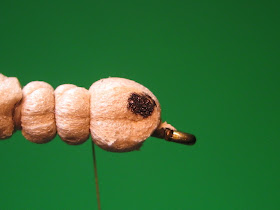This is my take on Charlie Craven's baby boy hopper. It is an excellent pattern to use early season, or for fish that are a bit too spooky to throw big terrestrials at. I also tie these on over-sized hooks to improve hookups. The above photo is a comparing the size #12 hook that the hopper is tied on, to a size #16 TMC 200R that fits the size of the hopper, but would close the hook gap dramatically.
Materials needed:
Hook: TMC 2499SPBL, or similar wide gap hook.
Thread: Tan UNI-thread 8/0.
Body: Tan foam. Black, olive, chartreuse, and yellow are also popular colors.
Wing: Elk or deer hair with and optional midge flash under wing.
Legs: Brown rubber legs.
Indicator: (optional) bright piece of foam.
Start by cutting a piece of foam to fit your hook.
For a size #12 hook, cut a strip of foam with a width of just over 1/8" and a length of just over 1". Make adjustments for larger or smaller hooks.
Cutting your foam to the proper size will reduce waste.
Pierce the foam about 1/4" from the end of the foam strip, and place the hook in your vise.
Using your bodkin, pierce a hole in the foam just behind the eye.
Measure to make sure you have enough foam to fold it over itself.
Remove the foam from the front of the hook, and start your thread just behind the hook eye.
Tie down a thin strip of foam tightly to the hook shank.
This piece of foam (binder) will stop the fly from rotating around the hook shank later.
Put your foam back over the eye of the hook.
Wrap a single wrap of thread over the foam to hold it in place.
Wrap tight enough to compress the foam, but not so much that it cuts the foam.
You can optionally add Zap-a-gap, or super glue to the foam before the next step.
Fold your foam over itself, and wrap 8-10 wraps of thread over the foam to make the back of your body segments. Your wraps should get progressively tighter as you wrap.
Pull your thread across the top of the foam, and make one or two wraps of thread.
Do not make too many thread wraps at this point, we will make thread wraps as we tie down materials.
Pull your thread across the top of the foam again to build your last segment.
Again, not too many thread wraps.
Apply some Zap-a-gap to the pieces of foam at the back, and sandwich them together.
Using a razor blade, cut the tail so the top is flat with the top of the body segments.
Cut a slight taper into the tail as well.
With your scissors, cut off all the edges to give the tail a rounded out look.
The sides of the head should be cut to match the sides of the body, and make some eyes with a Sharpie.
Tie a knot into your rubber legs.
Tie in your leg to the front segment, with 1-2 thread wraps.
Pull your thread across the top of the body segment, and tie down the back of the leg with 1-2 thread wraps.
These legs twist pretty easy. You can get them at the angle you want by twisting, and pulling them into place.
Tie in your other leg the same way, only start in the back.
Put a very small drop of Zap-a-gap between the front body segment, and the head. Before it dries, pull the front legs over the head.
This will keep the legs facing forward no matter how tightly you wrap your thread.
Optionally, you can tie in some midge flash as an under wing before you tie in you wing. The length should extend just beyond the tail.
Cut, clean, and stack a clump of elk, or deer hair, and tie it in tightly letting the butt ends flair. Wrap a few wraps of thread through the butt ends of the wing to make it solid. Make sure the wing stays on top of the body.
Optionally, you can tie in an indicator to improve visibility for yourself.
Whip finish, and trim your thread.
Add a small drop of Zap-a-gap to the top of the indicator, and let it soak into the top and sides of the hopper.




































